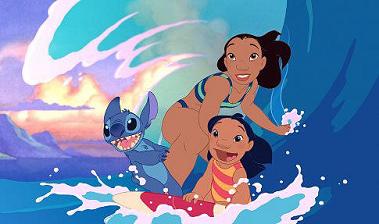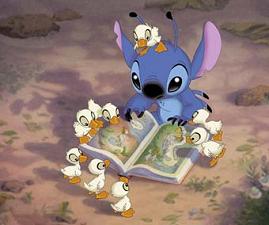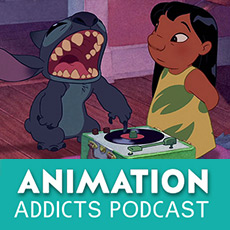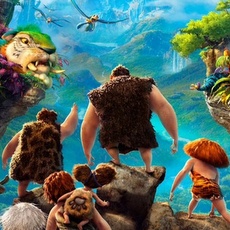 With Lilo & Stitch ready to gain new appreciation in a special Big-Wave 2-Disc Edition on DVD, it is clear that the unique personality of the movie is first and foremost the result of a unique collaboration between two directors (and screenwriters): Chris Sanders – the visionary – and Dean DeBlois – the storyteller.
With Lilo & Stitch ready to gain new appreciation in a special Big-Wave 2-Disc Edition on DVD, it is clear that the unique personality of the movie is first and foremost the result of a unique collaboration between two directors (and screenwriters): Chris Sanders – the visionary – and Dean DeBlois – the storyteller.
Born and raised in Colorado, Chris Sanders fell in love with animation at the age of ten after seeing Ward Kimball animated shorts on The Wonderful World of Disney. He began drawing, and applied to CalArts after his grandmother told him about the animation program at the school. He majored in character animation, and graduated in 1984, moving on to work at Marvel Comics. He came to Disney in 1987, working on The Rescuers Down Under (visual development and story), Beauty and the Beast (he storyboarded the death and resurrection of the Beast), The Lion King (design of the I Just Can’t Wait to be King and Mufasa’s ghost sequences) and Mulan (as a storyman).
A native Canadian, Dean DeBlois began his career working on animated programs produced by an Ottawa television station. After graduating from Sheridan University, he moved to Ireland to work with director Don Bluth, working on films like A Troll in Central Park (1993) and Thumbelina (1994). He joined the Walt Disney Company’s animation department in 1994, starting as a layout artist, and was soon head of story. The first film he worked on at Disney was Mulan (1998).
The following year, the two artists (now at this time of publishing in 2009 working at DreamWorks) were flying from California to Florida to work on Lilo & Stitch and give the film its unique and irresistible flavor. After discussing the details of the production with producer Clark Spencer, we asked them more specifically about what gives Lilo & Stitch that special flavor to their movie, especially through its storytelling and music.
 Animated Views: The first idea of the film dates back to a concept drawing of Stitch Chris did in 1985. He was first intended to be an ugly little creature living in complete solitude in a great northern forest. But how was Lilo and her passion for Elvis born?
Animated Views: The first idea of the film dates back to a concept drawing of Stitch Chris did in 1985. He was first intended to be an ugly little creature living in complete solitude in a great northern forest. But how was Lilo and her passion for Elvis born?
Chris Sanders: We needed a character that was going to really change Stitch and it seemed from the very beginning to both of us that a female character would be best to introduce him to the softer side of things, the more romantic side of things, and to the idea of family. We created Lilo very early on. The idea that she likes Elvis’ music came from the fact that we just wanted to make her very unique, initially. We also thought that, maybe, she found her mother’s records. She never listens to CDs in the movie; she always has vinyl records and a little record player that she holds around. So, that was the starting point for us.
AV: Does this choice have something to do with your personal taste in matter of music?
Dean De Blois: That’s a good question. I think we have very different taste. We’re both music fans. Chris is a big Elvis fan. I like Elvis as well, but I think my taste is more in the realm of alternative rock, whereas Chris is more into pop music. But we do have a common cross-over which is we both are big fans of movie soundtracks. So, when it came time for us to first work together on a film, working out what we could do for the film with the budget we had, we said we would try to save money wherever we can, but the one thing we don’t want to save money on is the music. We wanted to get the best score composer that we could possibly afford and the top of our list was Alan Silvestri because we are big fans of his work and we would often use his music as temporary scores when we were building films. So, we approached him and talked to him about the film and he was agreeable about doing it for we’d really like to have him on the film.
AV: How did you choose the Elvis songs you would put in the movie?
CS: Well, that kind of grew out of the situation that Lilo and Stitch were in. I think that it wasn’t hard to find songs that could illustrate almost every major part of film that we wanted to have music in. So, when they are spending the day together, it was a natural choice to use Stuck on You, for example.
DDB: For Heartbreak Hotel, I was just looking for a song that had a lyric within that kind of mimic how she was feeling. She’s “so lonely she could die”, just as a comic accentuation of her being so dramatic, locking herself in the house and playing Elvis music. Most of the songs were picked for some kind of a comic juxtaposition theme to what was going on in the sequence.
AV: Did some songs influence the storyline?
DDB: No, it was definitely the story first. In most cases, if you listen to the songs closely, they almost have nothing to do with what’s going on on screen, but there’s usually a line or a refrain or a title to the song that seems to complement what’s happening. Suspicious Mind, Stuck on You, Devil in Disguise: they apply to Lilo and Stitch and their situation. If you actually listen to Devil in Disguise, for example, it’s a song about a woman who turned out to not be as wonderful as Elvis thought she was, so that doesn’t really have anything to do with our story, but the title refers to an overall theme that evokes the personality of Stitch.

AV: Do you think Elvis was a “perfect citizen”?
CS: I idolized him because my family and my grandmother idolized him, and during the promotion of the film, we went to Graceland and we learned a lot more about him and how much he did for the community around him. He did a lot of work in charities and helped people out. He did it very quietly. He didn’t do that for the image. He was doing it to help his community. So, I think he really was a fantastic guy, with some multiple evidences of that. What was very interesting to me is that, in 1961, they were having problems in Hawaii raising funds for the USS Arizona memorial and he had a big concert and gave the proceeds to the memorial. That was striking to me.
DDB: I also think that, from Lilo’s point of view, because she’s so young and she has a very romanticized perception of the world, Elvis, to her is a hero. She doesn’t look at any of the bad sides of Elvis’ life. It’s all the good side!
AV: Speaking of the location: originally, the story was to be set in a forest. How did you come to take it to Hawaii?
CS: The idea of putting it in a forest is linked to the creation of Stitch, who was supposed to live a solitary live amongst animals. Almost immediately, we switched away from that, because when we first pitched to Tom Schumacher, the then-President of the Animation Studio, he had a very great observation. He said: “you know something: the animal world is, in a sense, overly alien to us. Putting Stitch into a human world is gonna give you a better contrast, a better juxtaposition, and it’s gonna give you a better story.” So, we went looking for a place to put that. We wanted to find a place that’s kind of a little bit remote, isolated. We needed an intimate setting, and we literally needed a place that couldn’t draw a crowd. We had just finished working on Mulan, where we were dealing with literally hundreds and hundreds of characters in the Imperial City and such.
We wanted to get back to just the main characters of this film, and we wanted to focus on that. So, we needed to bring the population way down. It seemed like a good idea to go to a place in America because we were also looking for a place that had a culture that we understood very well – we didn’t want to get locked down in cultural issues. And it was a few weeks after that decision that we had a map on the wall of Hawaii that we were taking a look at and that we realized that place had all what we were looking for, and that it also had an incredible beauty. It has so much to offer, visually. What we didn’t realize was how much it had to offer us culturally, but that led to a complete re-write of our story, when we discovered “Ohana”.

AV: Precisely. How did you discovery that beautiful concept?
DDB: It happened right away on the time when we took the research trip to Hawaii. We were working on the story for almost a year. We had storyboarded a lot of the film, we had written the most of it as a screenplay, but we were having a little trouble with the character of Stitch. He was supposed to undergo a massive transformation, and yet we didn’t a specific idea of what was going to cause that transformation. It was always about family, but it was a little vague and a little too universal to be specific enough for him to understand. When we went on this research trip, we had this tour guide who brought us around the island and he seemed to know everybody everywhere he went. We asked him about that later and he explained that he didn’t really know most of those people, but that it was just the Hawaiian way: you greet people as though they’re your brother or your sister. That what Ohana was. He explained us that it’s not about blood relations, but rather about being part of a larger community family. That became an idea that Stitch could really understand. So, we used it very heavily in the film to help him transformed with a very specific idea, one that was broad enough to include him.
AV: And at the same time, it was an interesting expansion of the Disney conception of family.
DDB: Yes. That was our intent. Disney is very famous for doing family films and we wanted to do a film that still fit in all that, and yet it’s more of an updated version. That includes all kind of families: broken family, single-parent family, groups of people that consider themselves to be part of a family even though they’re not related. We wanted to say that it’s what you make it. It’s about the choices you can make.

AV: How did you create the Hawaiian Roller Coaster Ride sequence?
CS: That’s a point of the film where you’re deep into the second act and there’s a lot of things going on. We realized, as we were building the movie, that you literally needed a place where you can just relax. That surfing sequence actually replaced a couple of other sequences that were very intense and very heavy. We were working very hard at that time to get across a couple of different story points. After viewing the film ourselves, we realized that it was getting a little bit dark in the second act and that needed a point where we could just relax, give a break.
That’s where that sequence really came from. And whenever you’re doing something like, a lot of time we find a piece of music that we put into the film temporarily that helps hold that piece of the movie in place. That piece of music has to have the spirit and the feel and pace of what we really wanted. So, we found a piece of music that was actually Tahitian and we temporarily paced it on top of a surfing sequence. The surfing sequence that you see is pretty much like the way it was very first boarded. There’s just a little bit of a story in the middle when you see Stitch watching Nani, Lilo and David, wishing that he’s a part of it, but a very sweet one, not very heavy. Then, when it came to music, we went to our Hawaiian contact – his name is Mark Keali’i Ho’omalu – and he was a Kumu Hula that had allowed us to shoot his dancers so that we can get the hula at the very beginning of the film completely correct.
He and Alan Silvestri had an incredible collaboration. Mark and Alan sat down with that piece of music that we had temporarily put in and they took a look at that to set the pace and the feel that we wanted. Mark went away and wrote an original piece of music that would give us that same spirit that we would put in there but was completely original and was Hawaiian. He wrote it for his voice and also for a choir to back him up on that. That’s really where it came from. It came from the desire to make a little space in the film where you could relax, have some fun and we just wanted to bring a certain level of energy and fuse it with Hawaiian spirit, and hopefully get across the audience. What it might feel like if you were there?
AV: That children choir brings a beautiful color to that song.
CS: Yes. When it came time to look for a choir, Mark led us to King Kamehaha School which is in Waikiki. We talked with the musical director there, Linell Bright, and they gathered about forty kids together aged 9 to 13 and they began practicing the song. That was an incredible moment in the production of this movie, flying to Hawaii and listen to that.

AV: Lilo & Stitch seems to focus on emotion rather than on action. Do you agree?
CS: Lilo & Stitch was conceived like a live action movie, despite the fact it’s an animated movie, be it visually or musically. It was very important for us that all the different aspects of the movie go in the same direction. That’s the only way to really involve the audience.
AV: What did you want to convey through this film, and through that emotion?
DDB: Chris and I wanted to convey a new approach to family, more in tune with present day life. It’s not about having the perfect family. What’s important is to have your own family.
CS: One of our first ideas was to propose a big change in the classical format of fairytales, with a villain that gets destroyed by the hero in the end. Stitch is a villain that becomes a comic hero. It was important for me to say that, if you’re not a hero, you’re not necessarily bad, and vice versa. You can make mistakes, like Stitch, but you have to get over that. That’s a very unusual message, especially for an animated movie.
With our sincerest thanks to Chris Sanders and Dean De Blois.







